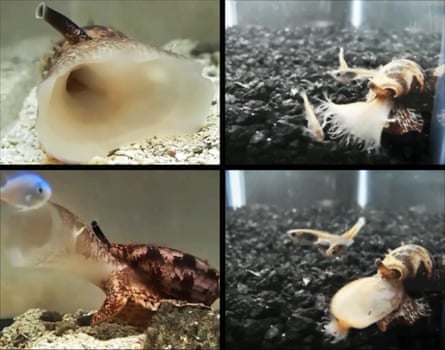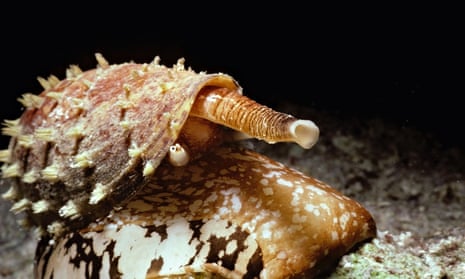A tropical sea snail uses a potent form of insulin to subdue its fish prey, scientists have discovered.
The geographic cone snail (Conus geographus) uses the chemical to cause a plunge in the fish’s blood sugar, leaving it sluggish and unable to escape. The snail can entrap whole schools of small fish in this way.
C. geographus is one of the most venomous creatures on Earth, and is known to have killed dozens of people in accidental encounters.
It hunts in two ways: by releasing toxins into the water and by firing a harpoon-like, poison-tipped tooth into its prey. No antidote exists for a cone snail sting, which contains a mixture of nerve agents.
The new research has uncovered one highly unusual ingredient in the snail’s toxin cocktail – weaponised insulin. In tests, a synthetic version of the hormone – made from shorter protein chains than normal insulin – lowered the blood sugar levels of adult zebrafish. Injected into water, it also reduced the movements of fish larvae.
US scientist Professor Baldomero Olivera from the University of Utah said: “This is a unique type of insulin. It is shorter than any insulin that has been described in any animal. We found it in the venom in large amounts.”

The insulin forms part of a poison mixture evocatively known as “nirvana cabal”. It allows the snail to disable entire schools of swimming fish by sending them into “hypoglycaemic shock”, a condition brought on by plummeting blood sugar levels.
The insulin is a stripped-down version of that found in fish, the scientists learned.
A second cone snail species, Conus tulipa, was also found to have insulin in its venom. But other species that only operate as “ambush hunters” did not possess the insulin toxin, and nor did those that prey on molluscs or worms.
Writing in the journal Proceedings of the National Academy of Sciences, the researchers concluded: “Evolving insulin to be used as a pharmacological weapon presents a novel and unexpected type of event in chemical biology.
“Our study reveals a class of insulins that have evolved to act rapidly and potently to cause severe hypoglycaemia.”
The snail insulin could prove to be a useful tool for probing systems that the human body uses to control blood sugar and energy metabolism, they said.
There are about 30 recorded instances of people being killed by cone snails, some of which have attractive and collectible shells. The molluscs are aggressive if provoked and their poison-loaded harpoons can penetrate wetsuits.
While the sting of a small cone snail is no worse than that of a bee, larger species can produce a potentially fatal reaction.

Comments (…)
Sign in or create your Guardian account to join the discussion